Research
Research in my lab focuses on investigating the ecology and evolution of flowering plants, with a primary emphasis on understanding their reproductive biology. Examples of my research (past and ongoing projects) include:
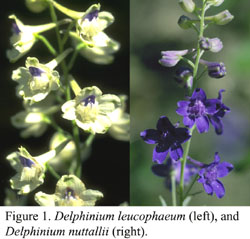 |
Diversification of Northwest Larkspur. Northwest species in the genus Delphinium appear to be a recently diverged group. Our studies have focused on determining the pattern and causes of diversification for two closely related species, Delphinium nuttallii and Delphinium leucophaeum. Flower color is the primary trait that distinguishes the two taxa, and D. leucophaeum has a very limited distribution and is State-listed endangered in Oregon.
We have used molecular genetic markers (primarily from the chloroplast DNA) to investigate the relationships among popualtions of the two taxa. A phylogeographic analysis of D. nuttallii from throughout its current range suggests that this species has expanded from a Pleistocene refugium in the eastern Columbia River Gorge (Dodd and Karoly, 2000; in prep). Our data for D. leucophaeum suggest that it may have diverged from D. nuttallii during the range expansion of D. nuttallii, making it less than 12,000 years old. Data from our analysis of ribosomal DNA suggests that introgressive hybridization may be occurring between D. nuttalli and D. leucophaeum where their ranges overlap in Washington state.
We are also investigating the biochemical and molecular genetic basis of the flower color difference between these two close relatives. Our crosses suggest that the white-coloration of D. leucophaeum is dominant to the more typical larkspur flower color shown by D. nuttallii. We are investigating pigment chemistry, gene expression and gene sequence differences for anthocyanin pathway genes for the blue- and white-flowered species, and also looking for ecophysiological differences that might accompany the flower color difference.
Results from both our flower color and phylogeogrpahy research were presented at the EVOWIBO conference in April 2004. Poster contents can be viewed here.
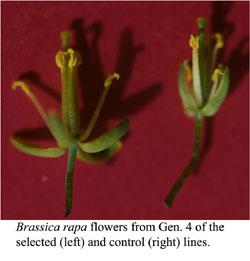 |
The Evolution of Floral Morphology in the Mustard Family (Brassicaceae) In collaboration with Jeff Conner (Michigan State Univ. and the Kellogg Biological Station), we have been investigating the evolution of stamen position in the mustard family. Our research has focused on understanding the roles of ontogeny, genetic architecture, and natural selection in determining the position of stamens in the mustard flower.
One goal of this collaborative project is to learn the evolutionary explanation for the long-term stasis of a trait that is diagnostic for the Mustard family -- tetradynamous stamens (four stamens with long filaments and two stamens with short filaments). In my Bio 332 course at Reed, we have used artificial selection on plants of the rapid-cycling Brassica rapa lines to demonstrate that the filament length dimorphism that is diagnostic for species in the Musatrd family can be readily altered by selection (see Figure at left; Karoly and Conner, 2000). A similar selection experiment was undertaken in collaboration with the Conner lab using Raphanus raphanistrum. In summer 2002, we placed the divergent lines in field arrays exposed to natural pollination ecology to be able to estimate the strength and direction of natural selection on the filament dimorphism (in a related question, we investigated selection on anther exsertion in summer 2001 - photos from the field). We are currently using genetic markers to determine pollen success for plants from field experiments in 2001 and 2002. This research has been supported by a grant from the Nattional Science Foundation Division of Environment Biology.
We are also investigating the patterns of floral development associated with the origin and subsequent loss of the filament dimorphism as a way to understand the role that development of genetically correlated traits might contribute to the stasis of the filament dimorphism. Results from this work were presented as a research poster at a research conference in Zurich in 2002.
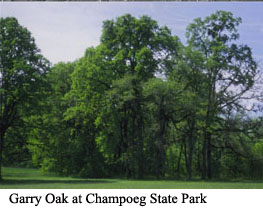 |
Phylogeography of Garry Oak Garry Oak (Quercus garryana) is the only native oak species currently found from the central Willamette Valley north to British Columbia. Results from our genetic investigations of Northwest larkspur populations led us to wonder if Garry Oak would show the same pattern of refugial isolation that we have observed for the larkspur species that inhabit plant communities in which the oak is a prominent component. Our initial studies of chloroplast DNA variation have provided a puzzling picture, with the Willamette Valley harboring the only variation we have observed. Lauren Mathewson, Lauren Byerley, and I presented our results at a Native Plant Conference in Corvallis in winter, 2003 (our poster).
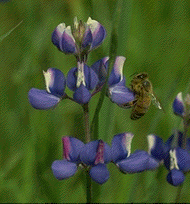 Lupinus nanusflowers, being visited by Apis mellifera. |
The Evolution of Mixed Mating in an Annual Lupine: Lupinus nanus is an annual lupine that possesses a mixed mating system, meaning that it produces seeds through both self- and cross-pollination. Although its flowers are visited in natural populations by insect pollinators, this species maintains the ability to produce fruit in the absence of pollinator visits. Theoretical models of mating system evolution in plants suggest that mixed mating systems are unstable over the long term. My work with L. nanus and its relatives focused on assessing the evolutionary stability of the mating system and has included determining the rates of cross pollination in natural populations, investigating the selective consequences of self- and cross-pollination, and identifying the floral traits that allow these flowers to produce fruit when they are not visited by pollinators.
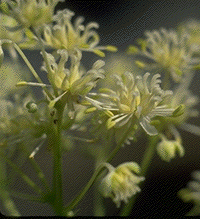 Female flowers of Thalictrum pubescens. |
Cryptic Dioecy in Tall Meadow Rue: Tall meadow rue (Thalictrum pubescens) is a native perennial of eastern North America that is morphologically androdioecious, but functionally dioecious (separate male and female plants). Female plants make stamens with pollen, but the pollen is believed to be sterile with no direct function. The goal of this research was to understand the evolutionary factors that might maintain sterile stamen and pollen production in females of this species. Field work for this project was conducted at the E. N. Huyck Preserve in New York state.
Publications
Waterman, R, H Sahli, VA Koelling*, K Karoly and JK Conner. 2023. Strong evidence for positive and negative correlational selection revealed by recreating ancestral variation. Evolution, 77: 264–275.
Sapir, Y, K Karoly, VA Koelling*, HF Sahli, FN Knapczyk, and JK Conner. 2017. Effects of expanded variation in anther position on pollinator visitation to wild radish, Raphanus raphanistrum. Annals of Botany 120: 665-672.
Conner, JK, CJ Mills, VA Koelling*, and K Karoly. 2014. Artificial selection on anther exsertion in wild radish, Raphanus raphanistrum. Scientific Data 1: Article number: 140027.
Conner, JK, K Karoly, C Stewart, VA Koelling*, HF Sahli, and FH Shaw. 2011. Rapid independent trait evolution despite a strong pleiotropic genetic correlation. The American Naturalist 178: 429–441.
Conner, JK, H Sahli, and K Karoly. 2009. Tests of adaptation: functional studies of pollen removal and estimates of natural selection on anther position in wild radish. Annals of Botany 103: 1547-1556.
Koelling*, VA and K Karoly. 2007. Self-pollen interference is absent in wild radish (Raphanus raphanistrum), a species with sporophytic self-incompatibility. American Journal of Botany 94(5): 896-900.
Matlaga*, DP., and K Karoly. 2004 Assessing the consequences of long-term cattle grazing on genetic variation in Idaho fescue (Poaceae) using ISSR markers. Journal of Range Management 57: 275-279. [PDF].
McGlaughlin, M*, K Karoly, and T Kaye 2002. Genetic variation and its relationship to population size in reintroduced populations of the pink sand verbena, Abronia umbellata subsp. breviflora (Nyctaginaceae). Conservation Genetics 3: 411-420.
Karoly, K, and J Conner. 2000. Heritable variation in a family-diagnostic trait. Evolution 54: 1433-1438.
Sweigart*, A, K Karoly, A Jones, and JH Willis. 1999. The distribution of individual inbreeding coefficients and pairwise relatedness in a population of Mimulus guttatus. Heredity 83 :625-632.
Thomson, JD, LP Rigney, K Karoly, and BA Thomson. 1994. Pollen viability, vigor, and competitive ability in Erythronium grandiflorum. American Journal of Botany 81: 1257-1266.
Karoly, K. 1994. Dioecy and gametophytic self-incompatibility: reproductive efficiency revisited. American Naturalist 144: 677-687.
Karoly, K. 1994. Inbreeding effects on mating system traits for two species of Lupinus. American Journal of Botany 81: 1538-1544.
Karoly, K. 1992. Pollinator limitation in the facultatively autogamous annual, Lupinus nanus. American Journal of Botany 79: 49-56.
Sakai, AK, K Karoly, and SG Weller. 1989. Inbreeding depression in Schiedea globosa and S. salicaria (Caryophyllaceae), subdioecious and gynodioecious Hawaiian species. American Journal of Botany 76: 437-444.
* Reed undergraduate